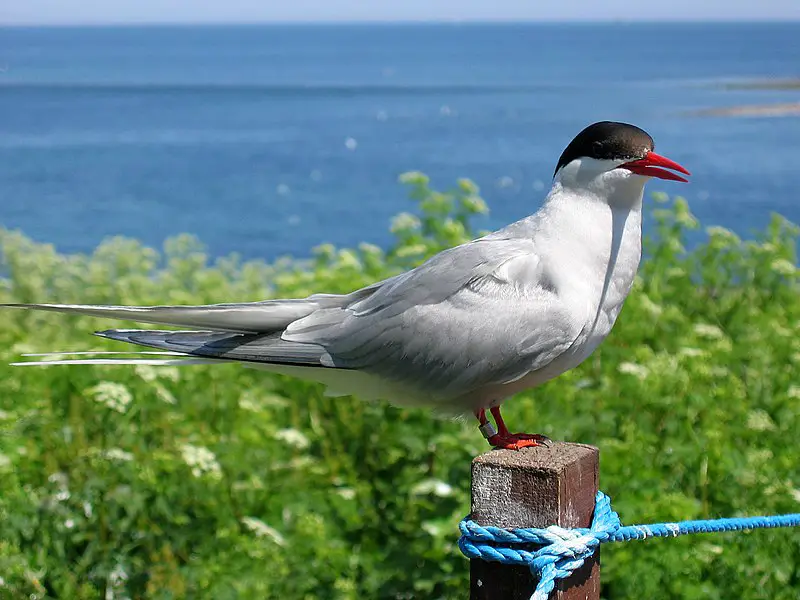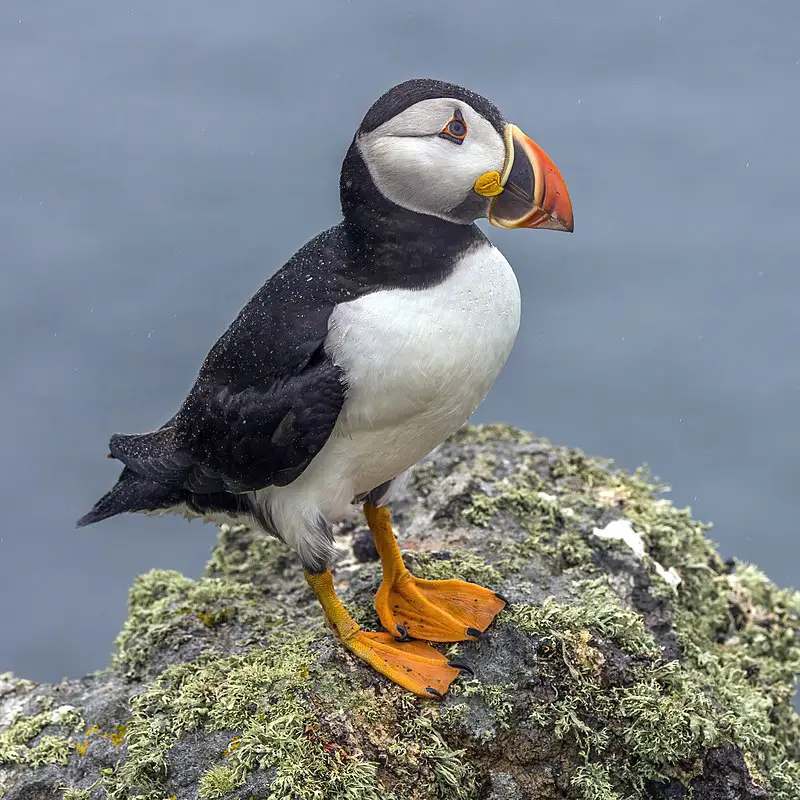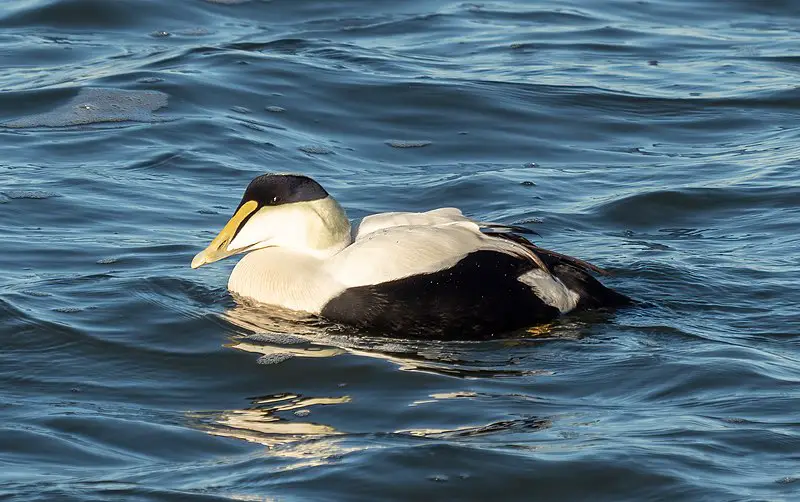Hog Island, located on the coast of Maine, is home to a diverse and captivating bird life. The island’s unique landscape, rugged rocky shores, dense woodlands, and rolling hills provide an ideal bird habitat.
From the iconic puffin to the elusive warblers, bird enthusiasts will be delighted with the variety of species found on Hog Island.
Whether you’re an experienced birder or a nature lover seeking a different adventure, Hog Island’s bird population will capture your imagination and leave you with a sense of wonder and appreciation for these feathered creatures.
10 Hog Island Birds That Live Around
Hog Island, located in Maine, USA, is a renowned birding destination known for its diverse avian population.
Here are 10 bird species commonly found around Hog Island:
1. Bald Eagle
The majestic Bald Eagle is a bird of prey found in North America and recognized as the national symbol of the United States.
With its distinctive white head, brown body, and striking yellow beak, this sea eagle has two known subspecies that form a species pair with the White-tailed Eagle.
It inhabits much of Canada, Alaska, all states in the US, contiguous area, and Northern Mexico near large bodies of water where they feed mainly on fish.
These birds have an impressive wingspan ranging from 1.8 to 2 meters depending on their size, making them one of nature’s most magnificent creatures.
Scientific classification:
| Kingdom | Animalia |
| Phylum | Chordata |
| Class | Aves |
| Order | Accipitriformes |
| Family | Accipitridae |
| Genus | Haliaeetus |
| Species | H. leucocephalus |
Also Featured In: Most Common United States Birds, Birds That Live in Colorado
2. Great Horned Owl
The Great Horned Owl is an impressive bird native to the Americas. It is well-known for its wide range and adaptability, as it can be found in many habitats across the continent.
Its diet consists primarily of rabbits, hares, rats, and mice; however, it also consumes skunks, geese, and other birds.
With their powerful talons capable of easily crushing prey, these owls have earned themselves a fearsome reputation due to their incredible strength.
Their iconic horn-like tufts on either side of their head add another layer of intimidation, which helps them stand out from other owls in the area.
Scientific classification:
| Kingdom | Animalia |
| Phylum | Chordata |
| Class | Aves |
| Order | Strigiformes |
| Family | Strigidae |
| Genus | Bubo |
| Species | B. virginianus |
Also Featured In: Most Popular Bird Species in North America, Birds Commonly Found in New York
3. Osprey
The Osprey is a majestic bird of prey with an incredibly wide habitat range. It has distinctive brown upperparts, greyish head, and underparts, making it easily identifiable in the skies above many regions worldwide.
With a wingspan of up to 180cm (71in) and a body length reaching 60cm (24in), this large raptor specializes in hunting for fish, soaring high over rivers and coasts, and searching for its next meal.
Despite living near water sources, they can also be found inhabiting mountainsides or even woodlands, proving their incredible adaptability. It is an impressive species that truly deserves admiration.
Scientific classification:
| Kingdom | Animalia |
| Phylum | Chordata |
| Class | Aves |
| Order | Accipitriformes |
| Family | Pandionidae |
| Genus | Pandion |
| Species | P. haliaetus |
Also Featured In: Ukrainian Birds You Should Know, Birds of Sweden
4. Arctic Tern

The Arctic tern is an incredible bird with remarkable migratory behavior.
It breeds in the northern regions of Europe, Asia, and North America during summer before migrating along a convoluted route to reach the Antarctic for winter.
This species has adapted extremely well to its environment – it can fly long distances while navigating easily, thanks to its excellent eyesight.
Furthermore, they can survive in temperatures as low as -40 degrees Celsius.
The Arctic Tern is also known for being one of the longest-living birds on Earth; some have been recorded living up to 30 years old.
Scientific classification:
| Kingdom | Animalia |
| Phylum | Chordata |
| Class | Aves |
| Order | Charadriiformes |
| Family | Laridae |
| Genus | Sterna |
| Species | S. paradisaea |
Also Featured In: Birds of United Kingdom, Most Common Scotland Birds
5. Black Guillemot
The Black Guillemot is a striking seabird throughout the northern Atlantic and eastern North American coasts. It has black feathers, white underparts, a red bill, and bright yellow feet.
They live in single or small groups around rocky shores, cliffs, and islands.
During winter months, they migrate southwards from their high arctic breeding grounds to search for food sources such as fish eggs or invertebrates like shrimp that can be caught near shorelines.
Their diet also includes seeds and berries during the summertime while nesting on coastal ledges, creating burrows where they lay up to four pastel-colored eggs at once.
These amazing birds are very efficient swimmers, using their wings and webbed feet to propel themselves through water quickly while hunting prey.
Scientific classification:
| Kingdom | Animalia |
| Phylum | Chordata |
| Class | Aves |
| Order | Charadriiformes |
| Family | Alcidae |
| Genus | Cepphus |
| Species | C. grylle |
Also Featured In: Birds You’ll Find in the Sea, Birds that Live in Greenland
6. Great Blue Heron
The Great Blue Heron is a majestic wading bird found in many parts of North America, Central America, the Caribbean, and even as far away as the Galapagos Islands.
It has an impressive wingspan which can reach up to six feet wide. Its feathers are mainly bluish-gray with brownish streaks on its neck and chest, while its head displays white plumes.
The adult herons can also be identified by their yellow bill and legs.
They live near bodies of water such as lakes, marshes, or rivers, feeding on fish using a spear-like motion with their sharp bills.
An all-white population exists only in South Florida and the Florida Keys, making it unique.
Scientific classification:
| Kingdom | Animalia |
| Phylum | Chordata |
| Class | Aves |
| Order | Pelecaniformes |
| Family | Ardeidae |
| Genus | Ardea |
| Species | A. herodias |
Also Featured In: Common Birds in Canada, Water Birds Live around Us
7. Atlantic Puffin

The Atlantic puffin is a seabird that belongs to the auk family. It has two related species found in the northeastern Pacific: tufted and horned puffins.
This bird breeds widely throughout Russia, Iceland, Ireland, Norway, Greenland, Canada’s Newfoundland & Labrador, and the Nova Scotia regions of the Faroe Islands.
Its colorful beak with yellowish-orange markings during mating season makes it stand out among other birds.
An interesting fact about this sea-dweller is its ability to fly underwater; it uses its wings for propulsion while swimming.
The Atlantic puffin diet consists mainly of fish caught from shallow waters near shorelines or cliffside, where they nest annually during springtime months before embarking on long migrations southward towards winter grounds at seaside coasts until spring returns once again.
Scientific classification:
| Kingdom | Animalia |
| Phylum | Chordata |
| Class | Aves |
| Order | Charadriiformes |
| Family | Alcidae |
| Genus | Fratercula |
| Species | F. arctica |
Also Featured In: Birds that Live in the Ocean , Most Common Nature Birds
8. Common Eider

The Common Eider is a large sea duck that inhabits the coasts of Europe, North America, and eastern Siberia.
It breeds in arctic regions and some northern temperate climates but travels further south during winter to form flocks with other ducks in temperate zones.
These birds are easily recognized by their wings’ characteristic black-and-white markings, which can be seen when they take flight.
They have light brown bodies topped off with bright yellowish coloured heads, making them quite striking creatures.
The eiders feed mainly on mollusks such as clams, mussels, snails, and worms at the bottom of shallow coastal waters or tidal flats.
Their diet helps improve water quality through natural filtering processes carried out by foraging for food underwater, which benefits local marine ecosystems immensely.
Scientific classification:
| Kingdom | Animalia |
| Phylum | Chordata |
| Class | Aves |
| Order | Anseriformes |
| Family | Anatidae |
| Genus | Somateria |
| Species | S. mollissima |
Also Featured In: Birds of Orkney, Birds that Live in Svalbard
9. Roseate Ter
The Roseate Tern (Sterna dougallii) is a species of bird that belongs to the family Laridae. It gets its name from its pink breast in breeding plumage, which gives it a “roseate” appearance.
The genus Sterna comes from Old English and means “tern,” while the specific refers to Scottish physician and collector Dr Peter McDougall (1777–1814).
This species was first described by George Montagu in 1813.
They are most common near coasts but can be found further inland occasionally, too. These birds mainly feed on small fish like sardines, anchovies, or herring and crustaceans when available.
They typically lay two eggs yearly during their breeding season between May and September before migrating south for winter.
Scientific classification:
| Kingdom | Animalia |
| Phylum | Chordata |
| Class | Aves |
| Order | Charadriiformes |
| Family | Laridae |
| Genus | Sterna |
| Species | S. dougallii |
Also Featured In: Ireland Birds, Birds of Farne Islands
10. Spotted Sandpiper
The Spotted sandpiper (Actitis macularius) is a small shorebird found across North America and parts of South America.
It has an appealing spotted plumage, predominately brown, with white spots on the wings, tail feathers, head, and neck.
The Common Sandpiper (A. hypoleucos) is its sister species, which takes over geographically when the other moves away; they have been known to hybridize when strays settle down among breeders.
This bird was first described by Carl Linnaeus in 1766 in his twelfth edition of Systema Naturae as a migratory summer visitor to Europe. Still, it also occupies many habitats like beaches, riversides, and grasslands during migration periods or for the breeding season itself.
Its diet consists mainly of insects such as air-borne flies and mollusks from shallow water areas, making them quite unique amongst waders.
Scientific classification:
| Kingdom | Animalia |
| Phylum | Chordata |
| Class | Aves |
| Order | Charadriiformes |
| Family | Scolopacidae |
| Genus | Actitis |
| Species | A. macularius |
Also Featured In: Suriname birds, Common Central Park Birds
Conclusion
Hog Island, nestled in the coastal landscapes of Maine, is home to a vibrant community of avian species. From majestic raptors like the osprey and bald eagle to elegant waterbirds such as the great blue heron and black guillemot, the island offers a diverse array of birdlife.
Shorebirds like the American oystercatcher and piping plover grace its sandy shores, while seabirds like the northern gannet glide over its offshore waters. Even the tiniest creatures, like the ruby-throated hummingbird, find sanctuary among the island’s flora.